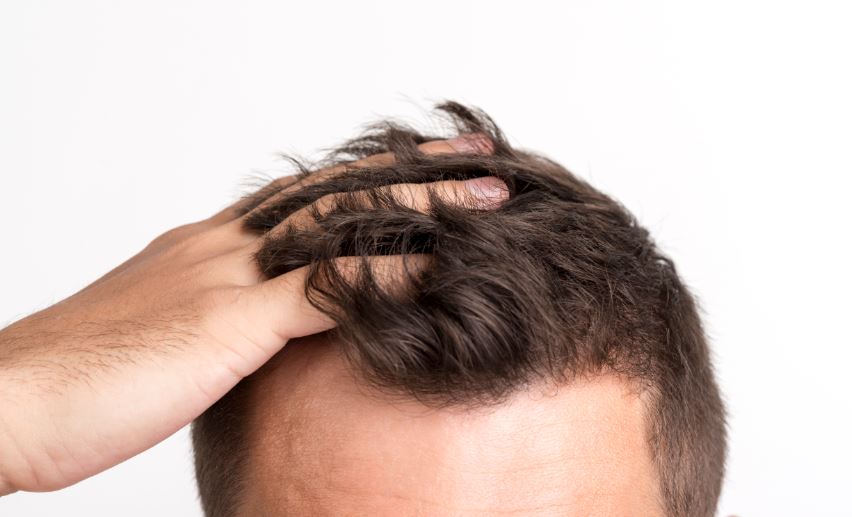Hereditary Baldness: What to Expect and How You Can Treat It
|
Reading time: 5 minutes
|

Experts estimate that around 66% of men will experience some degree of hair loss by the age of 35.
The vast majority of hair loss in men is caused by hereditary baldness.
Traditionally, hereditary baldness was untreatable; however, there are now many treatment options available to that still care about their hair!
Read on as we look at the best treatment options for those suffering from hereditary baldness.
What Is Hereditary Baldness?
The official medical name for hereditary baldness is androgenetic alopecia. It comes from your genes, meaning that you’re more likely to go bald if your father, older brothers, or uncles are bald.
Hereditary baldness can have different patterns. Some men will experience thinning hair throughout their whole head, yet retain the shape of their hairline; while others may see their hairlines recede completely (often in a horseshoe pattern).
Hereditary baldness is caused by a molecule called DHT. Every man has this molecule in their body, but some men are more sensitive to it than others.
DHT causes hair follicles to weaken and shrink. This causes the hair in the affected follicle to become thinner. Eventually, the follicle will break down entirely, and stop producing hair at all.
The scale for measuring the extent of baldness is known as the Norwood scale. This goes from 1 (negligible hair loss) to 7 (near-total hair loss).
What Are My Treatment Options for Hereditary Baldness?
There are a wide variety of treatment options for hair loss.
These vary widely in terms of both their method of use, and their effectiveness; we outline the pros and cons of the main treatments here.
Finasteride
Finasteride is regarded as the most effective medical treatment for hereditary hair loss.
Finasteride’s brand name is Propecia. The drug was first developed to treat prostate issues, but researchers discovered that it also had a positive effect on hereditary baldness.
The medication is taken in the form of a daily pill. The dose that is prescribed for hair loss is one-fifth of the dose prescribed for the treatment of prostate issues.
Finasteride works by reducing the amount of DHT in the body.
The treatment cannot repair follicles that have broken down fully. However, it can encourage growth in damaged follicles, and stop any further follicle damage.
Finasteride stops hair loss in the majority of patients. Some patients even experience moderate regrowth. Only a small minority do not see any benefit from using finasteride.
Minoxidil
Minoxidil is another treatment that is statistically effective in treating hereditary baldness.
Its ability to slow hair loss was also discovered by accident. It was originally used to treat high blood pressure.
Sold under the brand name Rogaine, minoxidil is a topical solution that must be applied to balding areas twice a day for optimum effectiveness, it comes in both liquid and foam.
Minoxidil comes in 2% and 5% solutions. Research shows that a 5% solution is more effective.
Scientists aren’t entirely sure why minoxidil is effective against hair loss. One theory is that it increases blood flow to the scalp, which allows more nutrients to reach hair coming from damaged follicles.
Minoxidil is also effective for the majority of men. However, while there are not many long-term studies to consult, anecdotal evidence appears to suggest that it is not as effective as finasteride over long periods.
Minoxidil and finasteride can be used in conjunction with each other.
Ketoconazole
Originally used to treat dandruff, ketoconazole shampoo is also a treatment for hair loss.; it’s sold under the brand name Nizoral.
Experts believe that washing your hair two to three times a week with ketoconazole shampoo can reduce the amount of DHT present on your scalp.
Ketoconazole is unlikely to have a significant effect on hair loss by itself. However, many men choose to use it in tandem with minoxidil or finasteride, or both; when used collectively, the treatments are sometimes known as the “Big Three.”
Hair Transplant
If you have already lost a significant amount of hair and wish to recover it, a hair transplant may be your only option. While medications can be effective in stopping hair loss, they won’t be able to provide complete regrowth.
Hair transplanting is done by taking hair from the sides and back of your head (which is usually impervious to hereditary baldness) and surgically implanting it into balding areas.
Follicular unit extraction (FUE) is the name of the procedure that surgeons usually use, nowadays; this involves the removal of follicles individually.
A process known as follicular unit transplantation (FUT) was once the industry standard, however this has become less popular as technology has improved. Patients that undergo FUE typically come out with superior results than compared to those that underwent FUT.
Hair transplantation is expensive and may take months until fully grown, however it’s a very successful intervention, and the results speak for themselves.
Complications are relatively rare, and many patients with severe baldness emerge with much fuller heads of hair.
Because the transplanted hair is usually taken from the sides of the head, it is immune to DHT and should not fall out once it has been transplanted. However, the natural hair that surrounds it is likely to fall out if you are susceptible to hereditary baldness.
For this reason, transplant surgeons usually recommend that patients take finasteride or minoxidil post-surgery.
Don’t Suffer in Silence
Once upon a time, hereditary baldness was a death sentence for men; other than a comb over (or toupee) there was little that could be done.
Nowadays, however, a wide range of options are available; get the treatment you deserve, and keep that hair where it’s supposed to be!
If you’re interested in reading more about hair loss medication, or any other medication that we stock, contact us today.
Information provided on this website is for general purposes only. It is not intended to take the place of advice from your practitioner







